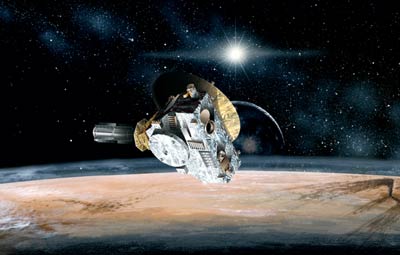anth
Member
|
# Posted: 19 Jan 2006 15:20
Reply
New Horizons - The Mission to Pluto and Beyond! - Blast Off!!!
Nothing makes old Anth nervous like a NASA rocket launch! I sat right here watching NASA TV's live coverage tonight, fingers crossed, and butterfly's in my tummy. I had no need to worry, as i viewed a seemingly flawless lift off of the New Horizon's mission to Pluto.
What a launch! Wonderful camera angles, superb mission coverage by NASA TV, as always. For those of us that watched, we saw the fastest ever ascent into space by any space probe.
9 years to wait now, not counting a flypast of the magnificient planet Jupiter in febuary 2007 by the pluto probe. Hopefully, that will be a good test for its onboard instruments. 9 years seems alot, but it will go quickly, i know, i remember writing an article for a small astronomy magazine reviewing the Cassini mission to Saturn, that was way back in 1997! Cassini is now into its second year at the ringed world. So, frighteningly, i'm telling myself, we'll be seeing those distant worlds of Pluto and its Moon Charon quite soon.
Any other OTF'ers put their name onboard the Pluto probe? Well, i couldnt resist, myself and Jadzia's names are safely tucked away onboard, racing now through space as i type. *L*

Liftoff -- New Horizons is On its Way!
Success! NASA's New Horizons spacecraft has launched from Cape Canaveral Air Force Station in Florida aboard a fast-moving Atlas V rocket. It's headed for a distant rendezvous with the mysterious planet Pluto almost a decade from now.

The third time was the charm for New Horizons. Two consecutive launch attempts earlier in the week were foiled by high winds at the launch site and a power outage at the Johns Hopkins University Applied Physics Laboratory in Laurel, Md., which operates the spacecraft now that the mission is underway.

Technicians work on New Horizons prior to its loading onto the Atlas V rocket.
CAPE CANAVERAL, Florida - The world's first mission to Pluto blasted into space on Thursday on an Atlas 5 unmanned rocket to begin a 9 1/2-year journey to the only unexplored planet in the solar system.
After two days of delays due to poor weather and a power outage, the 197-foot tall (60-meter) rocket, built by Lockheed Martin Corp., lifted off at 2 p.m. EST (1900 GMT) from Cape Canaveral Air Force Station.
High winds at the Florida launch site forced the first scrub of the launch of the New Horizons spacecraft on Tuesday, followed on Wednesday by a storm-triggered power outage at the mission control center in Laurel, Maryland.
With an unprecedented five solid-fuel strap-on boosters, the rocket sent the relatively tiny spacecraft into space faster than any object launched by man before. It sprinted into the sky and quickly disappeared over the Atlantic Ocean.
"The five solid rocket boosters are burning just fine, sending the New Horizons spacecraft on its way to the very edge of our solar system," said launch commentator Bruce Buckingham, shortly after the liftoff.
The launch sparked a small protest and was overseen by the Department of Energy because the spacecraft carried 24 pounds (10.9 kg) of radioactive plutonium that will decay over time, providing heat that the probe's generator can turn into electricity to power instruments and systems.
NASA has used the non-weapons grade plutonium, processed into ceramic pellets, for 24 previous science missions which, like New Horizons, travel too far to tap the sun's energy for solar power.
NASA chose the largest expendable rocket in the U.S. fleet to get the New Horizons spacecraft moving as quickly as possible on its 3 billion mile (4.9 billion-km) journey to Pluto. After additional boosts by two upper-stage motors, the probe was expected to move at 36,000 mph (57,934 kph).
Next year, the spacecraft is expected to pick up an additional 9,000 mph (14,483 kph) by bouncing off Jupiter's massive gravity field for a slingshot maneuver toward Pluto. Even so, it will take New Horizons until July 2015 to reach Pluto and its largest moon, Charon.



Our best views to date of Pluto. Imaged by the Hubble Space Telescope. As you can see, the resolution is far from desirable, hence the need for the New Horizon mission
Pluto is the largest and best known of a relatively new type of planetary body called a Kuiper Belt object. The Kuiper Belt is located beyond Neptune's orbit, which is 30 times farther away from the sun than Earth. It contains frozen objects believed to be leftover remains from the formation of the solar system 4.6 billion years ago.
While not much is known about Pluto, by the time the probe arrives, scientists may have a better idea of what to look for. A capsule containing samples of a Kuiper Belt-formed comet were returned to Earth on Sunday.
"For all the ideas and theories that people might have, we have some real ground truth," said University of Washington's Donald Brownlee, the principal investigator for the so-called Stardust mission.
"We have some actual samples of the material that the solar system was formed from," he said.

Pluto Movies ( Short animations, and webcasts, for Real Player. )
Next Stop: Pluto
http://mediaarchive.ksc.nasa.gov/dynavid....d=27650
Designed Specially for Pluto:
http://mediaarchive.ksc.nasa.gov/dynavid....d=27651
First Spacecraft to Pluto:
http://mediaarchive.ksc.nasa.gov/dynavid....d=27561
|

